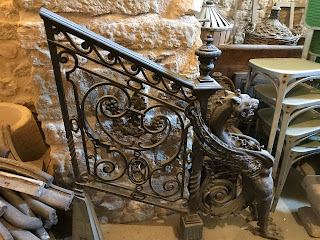So … in 3 B.C., Roman masons built a three-arch,
interlocking-limestone-block bridge over the Calavon River. At the time,
northern Italy and Spain were connected through southern France by the Via
Domitia, of which this bridge was a part. As we tooled around Provence, we saw
signs indicating remnants of the Via Domitia. And the bridge, Pont Julien,
named after Julius Caesar, still stands a few miles outside Bonnieux. Pont
Julien carried traffic for more than 2000 years, but today is reserved for
bicycle traffic.
Before the village of Bonnieux came to be, settlers
in the Luberon Valley lived down by the Pont Julien. At some point they felt
the need to protect themselves from enemies, so they moved into limestone caves
on the nearest hill.
Our Experience Luberon group got to tour one of
these caves! Our first Sunday in Bonnieux, we walked down from the old church
at the very top of the hill to the home of a friend of Kathy and Charley. Their
friend, Michelle, gave us a tour of her family home whose bottom level (the
cave) was built in the sixth century, the next level in the twelfth century,
and the top level in the eighteenth century. She had learned from archeologists
how the cave dwellers had lived there.
 Into dim golden light, we ducked our heads through
low tunnels and gingerly placed feet on uneven rock to hear Michelle tell about
the early inhabitants of her family home. She showed us where spring water
would have come in from a spot high on a wall. People had dug trenches to
direct the water where they needed it. She showed us a little alcove where they
would have hung game they had hunted. Again, trenches would have directed
animal blood away. A cool pit carved into the floor would have preserved meat.
People probably would have slept on a slightly elevated more-or-less flat area
in the same “room.”
Into dim golden light, we ducked our heads through
low tunnels and gingerly placed feet on uneven rock to hear Michelle tell about
the early inhabitants of her family home. She showed us where spring water
would have come in from a spot high on a wall. People had dug trenches to
direct the water where they needed it. She showed us a little alcove where they
would have hung game they had hunted. Again, trenches would have directed
animal blood away. A cool pit carved into the floor would have preserved meat.
People probably would have slept on a slightly elevated more-or-less flat area
in the same “room.” This beige cave led into another, and then another,
all paths and walls very roughly hewn inside the mountain. In this
higgledy-piggledy cave arrangement, early inhabitants crushed grapes, ground
grain, skinned animals, tanned hides, and cured meats. Imagine the smells!
This beige cave led into another, and then another,
all paths and walls very roughly hewn inside the mountain. In this
higgledy-piggledy cave arrangement, early inhabitants crushed grapes, ground
grain, skinned animals, tanned hides, and cured meats. Imagine the smells!
At some point, probably the early 1100s, the Knights
Templar lived in Michelle’s caves. I am not sure if it was they who built the
second level, but whoever did carved the year 1130 into the wall. Front-line soldiers lived
in the bottom caves and officers lived on the next level up. A hole in the bottom-cave
ceiling was a “shouting tube” through which officers could shout down orders to
their men. Upstairs, the shouting hole had a stone plug in it.
Michelle’s grandfather was an
expert ironworker. She showed us a model he had made for a railing he was
commissioned to make for LeTrain Bleu restaurant in the Gare de Lyon in Paris.
His ironwork’s ornateness was quite the contrast to the crude, but effective,
chipped, gouged limestone of the cave dwellers.
Bridge photo credit: www.editionsaris.com. I bought this bridge postcard.






















